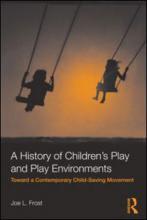
With more than 50 years experience in research and teaching, Joe L. Frost, EdD, Parker Centennial Professor Emeritus, University of Texas at Austin, wrote A History of Children's Play and Play Environments: Toward a Contemporary Child-Saving Movement published by Routledge in 2010. He authored numerous books and articles on the subject of play, playgrounds, safety, children’s poverty, and play and child development.1
From the perspective of historical play, Dr. Joe Frost described the theories of play expounded by philosophers through the ages, the types of play children engaged in, and the child-saving movements of the 1800-1900s that were championed by social reformers for the good of children. Dr. Frost closed his book with an overview of the value of play, the consequences of play deprivation, and the renewed interest in a contemporary child-saving movement to promote free play, outdoor play, and healthy living.
Chapter 1 outlines the theories of play from the early Greek and Roman philosophers, Plato, Aristotle, and Quintilian; the educators of the Reformation and Renaissance, Martin Luther, John Comenius, and John Locke; to the pre-modern thinkers of the 1700-1800s, Jean-Jacques Rousseau, Johann Pestalozzi, and Friedrich Froebel.
Chapter 2 describes the play and play environments in early America from colonial times through to the western expansion. The play of Native American children as well as the play and work of the children of slavery is shown to influence the “transference of cultures across generations.”
The early child-saving movement, where social reformers engaged in rescuing children from crime, homelessness, child labor, child abuse, and poverty, is described in Chapter 3. Many organizations were established for children, such as the YMCA, Girl Scouts, Boy Scouts, and Camp Fire Girls, during this time as well as child welfare programs, child labor legislation, and compulsory education.
The play and playground movement was influenced by the outdoor gymnasiums proposed by the Germans and the child study movement of the early nursery and kindergartens. Chapter 4 follows the history of playgrounds from the early 1800s through the early 1900s with the introduction of sand gardens to playgrounds with play equipment. Chapter 5 addresses the child study movement with the development of early childhood education and kindergartens and their philosophies of incorporating play. During this time, many professional organizations that advocated play were founded and many continue to exist today.
Chapter 6 describes play during the Great Depression that hit in 1929. Though times were hard, children continued to find ways to play when they had the opportunity. This chapter contains many vivid stories of the difficult conditions children experienced and the games they played.
Natural playgrounds, built playgrounds, and adventure playgrounds emerged during the 1900s. The benefits of nature play, while readily available for rural families, were seen as important for urban children as well. Chapter 7 describes the move toward manufactured playgrounds built of wood and steel at first that later were replaced by plastic materials and modular designs. Children playing in vacant lots, construction sites, and garbage dumps spawned the adventure playgrounds, where children could create their own play spaces with loose parts, scrap materials, and tools.
Chapter 8 relates the developmental and therapeutic value of play and contrasts the results of play deprivation. The abandonment of outdoor play, reduced recess and physical education, and diets of junk food have resulted in increased childhood obesity and serious consequences on children’s developmental skills. Excessive playground safety standards, lawsuits, and over-protective parents also threaten traditional outdoor play.
The final chapter recounts the renewed interest in a contemporary child-saving movement to reintroduce children to nature and outdoor play with opportunities for spontaneous free play. The book offers suggestions to confront the play, fitness, and health crisis of children, such as better nutrition, less time using electronic devices, and more activity and play at school and at home.
With lessons to be learned from the history of play and play environments, Dr. Frost strove to encourage the contemporary play movement to continue its advocacy for play.2

